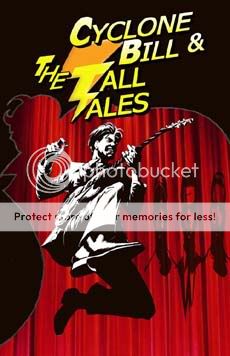Cyclone Bill and the Tall Tales
Dan Dougherty, writer/artist
Moonstone, 2006
232 pages
$16.95
Fictional comic stories about music are often not just bad, but embarrassingly, infuriatingly bad. I’m not sure why this is, to be honest. I think the answer may be found in noting the tendency of stories about obscure/failed/garage/shitty bands/music (e.g. Jaime Hernandez, Gipi, Bryan Lee O’Malley, Makoto Yukimura) to be much much better than stories about famous/successful/stylish/supercool bands/music (you can probably rattle off the names of several such failed series from the past five years, easy).
First, the roundabout explanation. When you’re tackling music just as a thing people do out of compulsion or enjoyment, independent of external payoff, that’s universal. But when you’re approaching music as something that makes its practitioners that much more awesome than everyone else, you invite your readers to compare your depiction of that awesomeness to what they, personally, find awesome about the music they find awesome. And when that comparison clashes–as it often does, because rock-star hero worship is an enormously personal thing, millions of idiosyncratically intimate relationship established with fantasy figures–it’s throw-the-book-out-the-fucking-window time. The book ends up feeling…like a costume, a disguise, not like an outfit. (Weirdly, I don’t think this rule applies as neatly to movies as it does to comics. Maybe it’s because movies have an inherent glamour to them that comics don’t, so they can address the glamour more naturally, I don’t know. I really like Eddie & the Cruisers, is what I’m saying.)
But a more direct explanation would simply be “show, don’t tell.” In my experience, comics-about-music that pivot off the involved parties’ coolness tend to absolutely bury the reader in LOOK HOW COOL THIS STUFF IS!!!!isms, which is death for coolness in fiction as it is in real life. (Seriously, people who think Geoff Johns lays on the Hal Jordan hero worship too thick in Green Lantern need to get back to me after reading any recent series that invokes the British rock tradition in any way.) You don’t see the flopsweat when reading about the misadventures of Sex Bob-omb or La Llorona–they just do what they do, and that’s why it works.
Cyclone Bill & the Tall Tales falls somewhere in the middle, in large part because of what an odd, odd book it is. I stumbled across one of the single issues while working at Wizard, in a pile of the “well, somebody out there’s readin’ it, I guess”-type comics that tended to accrue here and there. It’s done in a painted, grey-tone black-and-white style that really does have more in common with alternative comics than “indy comics” of the sort you might expect from a publisher whose bread and butter is the randomest bunch of licensed properties you can imagine. (Kolchak the Night Stalker!) Writer/artist Dougherty’s work here is undoubtedly the work of a young cartoonist–it’s stiff at times, unequal to the tasks he sets for himself (like the first-person POV videotape mockumentary storytelling device that recurs throughout) at others–but there’s also much to admire and enjoy, from the attractive character designs to the stark, angular, expressionist overall look.
Moreover, the story boasts gratuitously weird elements galore. The nominal protagonist, documentarian Margarita Bloom, spending what seems like half the book asleep on the couch. Cyclone Bill, the titular guitar god whose untimely onstage murder (yep, it’s that kinda deal) is the center of the story, is a classically trained prodigy from Poland who toured the great halls of Europe before disappearing to become a Catholic priest or something, then reemerging as the second coming of Jimi Hendrix after plucking an undistinguished American bar band out of obscurity and joining them as their lead guitarist. Dougherty even casts himself and his real-world bandmates as main characters–Bill’s band, the Tall Tales. It’s all really quite singular, especially because Dougherty has left this sort of comic behind–he now does a humor strip about a coffee-shop clerk with a web page done in Comic Sans. Then as now, my first thought upon looking at this book is “Where the heck did this thing come from?”
This is not to say that the story doesn’t traffic heavily in traditional signifiers of cool, because it does. It’s the sort of comic in which a recreation of the famous photo in which Johnny Cash flips off the camera is used as a major plot point, if that helps. But in the main, it’s trafficking in such a hoary, out-of-fashion brand of rock and roll coolness that it’s practically gone all the way around to uncool again. Robert Johnson at the crossroads, Elvis Presley still haunting the highways of the Great American Nowhere, sinister significant others in the Yoko Ono role, a slogan-spouting punk as the antagonist, deals with the Devil in which souls are sold for rock ‘n’ roll, a celestial gathering of dead rock stars…this is your father’s musical mythmaking. Yeah, I cringed a little when Freddie Mercury, Kurt Cobain, John Lennon, Jim Morrison, and Elvis Presely teamed up to kick Satan’s ass around Graceland, but not as much as I’d have done had Jarvis Cocker been involved, you know? It’s far enough away from where I am not to clash so violently.
No, it’s not the Velvet Goldmine of comics I’ve long hoped for–a story that’s both reality-warpingly personal in its approach to the musical icons it’s dealing with, but also accessible enough to people who aren’t the creator to reveal something about the music and musicians involved, and entertaining enough for that not even to matter. But it is Doughterty laying it all on the line in terms of his love for a certain rock and roll tradition, fashion be damned, and that’s admirable in its own way. It’s a fictional comic about music that didn’t make me want to light it or myself on fire by the end, which is an achievement in and of itself.
Tags: comics, comics reviews, Comics Time, reviews

